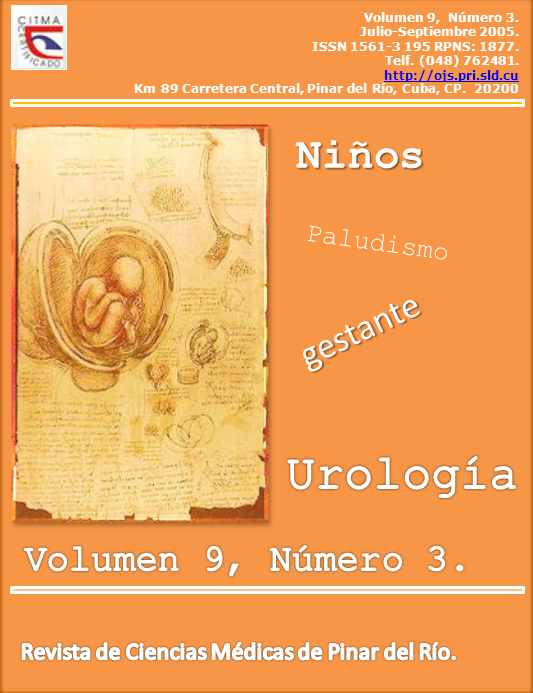El diprivan como reductor de la incidencia de vómitos en niños amigdalectomizados The use of Diprivan to reduce the incidence of vomits in children undergoing tonsillodectomy
Resumen
El Diprivan por sus características farmacológicas es uno de los logros en el campo de la anestesiología. Sus propiedades antieméticas dadas por actividad antidopaminérgica y efecto depresor sobre la zona quimiorreceptora de disparo emético bulbar son útiles en la cirugía ambulatoria. Realizamos un estudio prospectivo y longitudinal en 60 pacientes amigdalectomizados, en el Hospital Pediátrico "Pepe Portilla" entre marzo de 2002 a enero del 2004, con el objetivo de comparar la incidencia postoperatoria de vómitos al utilizar Diprivan o Halotane como anestésico base en las amigdalectomias. 60 niños del perímetro urbano fueron enrolados en el estudio y elegidos al azar para recibir una de las propuestas anestésicas. Un acceso intravenoso fue establecido y todos los niños recibieron Fentanyl (2 µcgr. Kg. ev ) y Lidocaína 2% (1mg.kg.ev). A 30 niños se le administró Diprivan 2mg.kg como agente inductor y al resto inducción con máscara con Halotane (3-4%), O2 100%. La intubación endotraqueal fue facilitada con Atracurio (0.25mg.kg.ev). Seguidamente a la misma recibieron Diprivan (120-180µcgr .Kg. min. ev) o Halotane (0.8-1.6%) indistintamente con O2 100% para el mantenimiento de la anestesia. Los episodios de vómitos fueron recogidos en las 6 horas siguientes antes del acta y una entrevista telefónica fue realizada al siguiente día. De un total de 29 pacientes que presentaron vómitos el 89.7% correspondió al grupo del Halotane y solo un 10.3 % al del Diprivan. p< 0.01. Estos datos sugieren que utilizando Diprivan como anestésico podemos disminuir la incidencia de vómitos siguiendo a una amigdalectomía.
Palabras clave: DIPRIVAN, NAUSEAS, VÓMITO, POST OPERATORIO.
ABSTRACT
The Propofol for its pharmacological characteristics is one of the achievements in the field of the anesthesiology. Their properties antiemetics given by activity antidopaminergics and effect depressor on the quimiorreceptora area of shot emetic bulbar are useful in the ambulatory surgery. We carry out a prospective and longitudinal study in 60 patient amigdalectomized, in the Pediatric Hospital "Pepe Portilla" among March of the 2002 to January of the 2004, with the objective of comparing the postoperative incidence of vomits when using Diprivan or Halotane like anesthetic bases on the amigdalectomy. 60 children of the urban perimeter were signed up in the study and chosen at random to receive one of the anesthetic proposals. An intravenous access was established and all the children received Fentanyl (2 µcgr. Kg. ev) and Lidocaína 2% (1mg.kg.ev). To 30 children´s was administered Diprivan 2mg.kg as agent inductor and to the rest induction with mask with Halotane (3-4%), O2 100%. The endotraqueal intubation was facilitated with Atracurio (0.25mg.kg.ev). Subsequently to the same one Diprivan received (120-180µcgr. Kg. min. ev) or Halotane (0.8-1.6%) indistinctly with O2 100% for the maintenance of the anesthesia. The episodes of vomits were picked up in the 6 following hours before the records and a phone interview was carried out to the following day. Of a total of 29 patients that presented vomits 89.7% it corresponded to the group of the Halotane and alone 10.3% to that of the Diprivan. p<0.01. These data suggest that using Diprivan like anesthetic can diminish the incidence of vomits continuing to an amigdalectomy.
Key words: DIPRIVAN, NAUSEAS, VOMIT, POST OPERATIVE.
Descargas
Cómo citar
Número
Sección
Licencia
Aquellos autores/as que tengan publicaciones con esta revista, aceptan los términos siguientes:- Los autores/as conservarán sus derechos de autor y garantizarán a la revista el derecho de primera publicación de su obra, el cuál estará simultáneamente sujeto a la Licencia de reconocimiento de Creative Commons que permite a terceros compartir la obra siempre que se indique su autor y su primera publicación esta revista.
- Los autores/as podrán adoptar otros acuerdos de licencia no exclusiva de distribución de la versión de la obra publicada (p. ej.: depositarla en un archivo telemático institucional o publicarla en un volumen monográfico) siempre que se indique la publicación inicial en esta revista.
- Se permite y recomienda a los autores/as difundir su obra a través de Internet (p. ej.: en archivos telemáticos institucionales o en su página web) antes y durante el proceso de envío, lo cual puede producir intercambios interesantes y aumentar las citas de la obra publicada. (Véase El efecto del acceso abierto).



